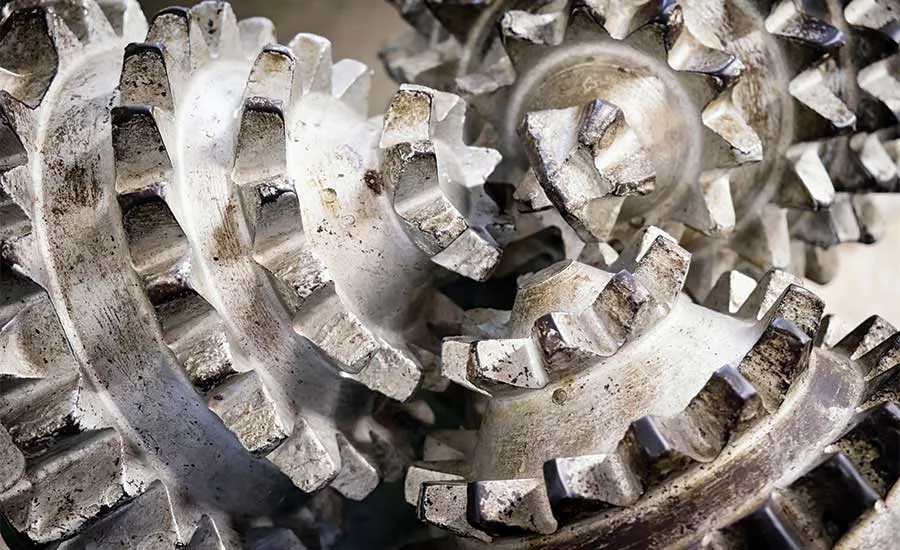How Does Bit Weight Affect Success on Drilling Jobs?

In order to work properly, every bit is designed to run with a given amount of down pressure. It takes a certain amount of push. When drilling vertically, this is bit weight. Whether drilling with a tricone bit, polycrystalline diamond compact (PCD) or hammer bit, the manufacturer sets an ideal weight to get the best performance. Different manufacturers will have their own chart or formula. Knowing the correct bit weight will help you get the most out of that bit.
I’m a drill pipe guy. I do not sell bits. So, why do I care about bit weight? Let me explain.
Several years ago, I received a call from a driller who reported a problem breaking off drill pipe pins. He had one break and didn’t think much of it until another broke a few days later. He then had his drill pipe inspected and gave me a call.
“I am having a problem with two pins breaking and cracking on others,” he says.
“How many are cracked?” I ask.
“All of them.”
Yikes!
That would be all 60 of them. We asked some questions about the hole size, depth and drill string makeup. He was working on 12¼-inch holes that were 1,100-feet deep. He was running 4½-inch drill pipe, a tricone bit and a 15-foot stabilizer. Thus, the need for this column.
For DTH hammer bits, I have seen a set weight of 6,500 to 7,700 pounds total bit weight, and also a “rule of thumb” that said 500 pounds for every inch of bit diameter. Here, a 6-inch hammer bit would require 3,000 pounds of bit weight. Hammer bits cut by pulverizing the rock through strikes of the piston against the top of the hammer bit. The idea that DTH hammers do not need gobs of weight is a great advantage in the right formations.
With tricone bits, the recommended weight is a lot more and will depend on the size or formation. For tooth bits, the weight can range from 1,000 to 4,000 pounds per inch of bit diameter. For tungsten carbide insert (TCI) button bits, this can increase to 6,000 pounds per bit inch. So, when you stick on that 12¼-inch button tricone bit in a medium-hard formation, you may need 36,000 to 72,000 pounds of bit weight for the bit to perform as designed. That’s a lot of weight, and weight is expensive. Tricones work by crushing the rock when the tooth or button is forced into the rock. This is why they need more weight.
PDC bits have become more popular for applications in rock formations up to 25 kilopounds per square inch (KSI). Here the recommended bit weight can vary up to 3,000 pounds per bit inch. PCD bits cut by shaving the rock. If you’ve been in a machine shop and have seen carbide inserts for cutting metal, you get the idea. (Thank you to Todd Taylor with Infinity Tool Mfg. for the info.)
In traditional oilfield applications, this requirement is why the big rigs run strings of drill collars.
To get 36,000 pounds of bit weight, they would run eight joints of 8-inch-by-31-foot drill collars. These would sit above the stabilizer, or bit sub and bit. Once they have attained the desired bit weight and drill pipe is added, the rig will actually go into a hold back mode when the weight of the collars and drill pipe meet the recommended bit weight. This is how drill pipe is designed to operate — in tension.
That’s oilfield. In water well or shallow oil and gas, we use rigs that have pulldown. When we drill the top hole, we make up for the lack of weight by pushing with the rig’s hydraulics. Here, pulldown is your friend. However, as the hole gets deeper and more rods are added, we start pushing on more sections of drill pipe. At some point, the drill rods bow out or “snake” in the hole.
This is bad news for the drill pipe as it and, crucially, the connections rotate through the bends, the surface continually stretches and compresses, creating fatigue stress. Since fatigue is cumulative, this will eventually cause a failure — and not with just one or two joints. Once the hole is started, it is good drilling practice not to rely on pulldown for bit weight.
Relying on your rig’s pulldown for bit weight can lead to drill rod disasters such as broken pins, cracked boxes and tube breaks. Instead, design your string to put the required weight nearest to the bit, ideally holding back and running your drill pipe in tension and keeping your hole straighter.
Keep in mind also that you might want to watch the weight on your DTH hammers. Ask your hammer supplier what the bit weight should be. Too much weight has a negative effect on hammer performance. After all, you exceed 3,000 pounds with 200 feet of 4½-inch drill rod.
How do you monitor bit weight? I asked my good friend Mike Shumway with Noland Drilling Equipment, a Schramm dealer, and he sent me information on Schramm controls for “downfeed” and “holdback.” If you are not sure, check your manuals.
Bit weight. It’s one of many factors in drilling performance, the life of your drilling tools and your bottom line.
Looking for a reprint of this article?
From high-res PDFs to custom plaques, order your copy today!



